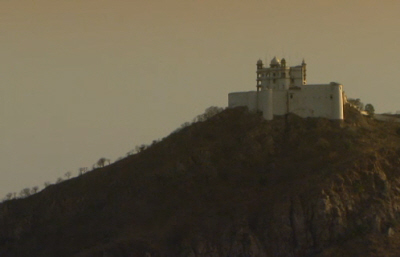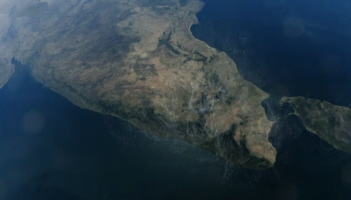Monsoon
The Biggest, Single Weather Event on the Planet

Busy Udaipur
As May turns to June, the volatility in our atmosphere drives the biggest single weather event on the planet. An event centred on the Indian subcontinent. This is the city of Udaipur in Rajasthan. It's in the north-western corner of India. Since March, temperatures here have been steadily rising as the Earth's tilt has warmed the northern hemisphere. But by June, everything is on the brink of an exhilarating change.
I'm here at the time of an epic weather event of huge importance not just to Rajasthan but to the whole subcontinent and the over billion people who live here. There's a wonderful place to appreciate the significance of this even, on one of the hills that overlook the city, here, at this cliff-top palace.
It was built at the end of the 19th century by the 72nd Maharana of Udaipur and it's known as Sajjan Garh. Although now abandoned, Sajjan Garh's halls and courtyards still, have an evocative fading grandeur.

Hilltop Palace, Rajasthan
The Palace was designed with a whole series of balconies and verandas and you do get the most staggering view of the city from up here. But that's not what the Maharana was interested in. He built this palace to get a pure, unadulterated view of the sky and the clouds that start to build at this time of year. Sajjan Garh is the monsoon Palace.
When the rains do eventually arrive, they'll be an essential relief from the heat of the Indian summer. But what's intriguing is that the monsoon is actually a consequence of the rising seasonal temperatures that precede it. To reveal why this is, we need to travel 2000 km. south. To the coastal state where the monsoon first arrives in India, Kerala. The key to understanding the monsoon is here, on the beach.
The monsoon is powered by a simple, but incredibly significant difference, the difference between land and sea. And in particular, the differing ways in which they respond to the sun.

India Coastline
This water is much warmer than the sea at home but it's much cooler than the beach and the reason for that is that the ocean takes much more of the sun's energy to heat it up. So a kilogram of water will take three times as much energy as a kilogram of sand to heat by 1°. The ocean is also relatively cool because to heat the surface you have they each much more than just a thin layer. What happens is that winds that blow across the surface of the ocean generate turbulence which mixes that top layer. So as soon as some waters been heated at the top, it gets mixed down below.
This means that, unlike the land, the ocean warms up only very slowly, as the sun's energy is absorbed. So as we enter summer, the land heats up quickly, while the ocean lags farther and farther behind. This increasing temperature difference is critical, because both land and sea heat the air above them. As the sun has baked the Indian subcontinent, the land has warmed the air above it. The warmer air is less dense, so it rises. This draws in the cool air from ocean. Because of India's particular geography, this process is magnified. It's a triangular peninsular, with a wide, hot plains and, crucially, a very long coastline. This combination sets up a powerful and sustained movement of cooler ocean air, the monsoon wind.
There is an enormous process on the go here. When the sun shines down on the ocean surface, some of the water at the surface will evaporate, so water and energy are carried up into the atmosphere. And as the monsoon winds come inland they carry that water vapour with them, the heated land makes that moist air rise, goes up into the clouds and there droplets condense, the water condenses out, becomes visible, we see clouds. When those droplets joined together to form droplets which are large enough, we get rain. So, the rain we are seeing now is a thin layer of the ocean that's been lifted up, shifted over the land and is now being dumped on top of me.
None of this would be happening if it wasn't for the Earth's tilt. It's the seasonal heating that widens the gap in temperatures between the land and the sea, this drives everything. And this massive system of rain and wind rushes inland and that's the monsoon.
80% of all India's rains arrive in this seasonal deluge. It's not just the volume of the monsoon rains which is impressive. It's the distance they travel. As summer progresses in India, the difference in temperature between land and ocean actually increases. This makes the whole monsoon system more powerful, drawing this moisture laden air farther and farther inland. From when the monsoon first arrives on the Kerala coast around June 1st, it spreads more than 2000 km that eventually reaches the far north of the country, including Rajasthan.
It's remarkable that the moisture laden winds that originate many hundreds of kilometres to the south of here are still capable of delivering rain in Rajasthan. The rains aren't nearly as heavy here as they are in Kerala. They tend to fall in short bursts and sometimes there are several days between downpours and sometimes the monsoon fails altogether. So effective systems of storing rainwater are critical.

Lake Palace
This is Lake Pichola, and for the tourists that flock to Udaipur in their thousands, it's a must see on their itinerary. But the jewel is this, the Lake Palace, which looks like it's almost floating on the surface and is entirely surrounded by water.
But what's truly surprising is that this lake isn't natural at all. It's a man-made reservoir built specifically to capture those precious monsoon rains. It was built hundreds of years ago and covers about 7 square kilometres. Even a reservoir of this size doesn't guarantee the people of Udaipur a permanent supply of water. As recently as 2009, when the monsoon failed here, the entire lake dried up. A stark reminder that the balance of life in this part of India is totally dependent on the differing ways that the land and the ocean respond to the sun.




